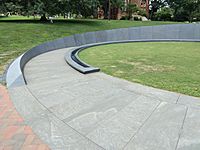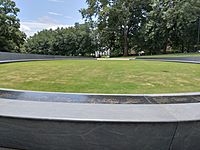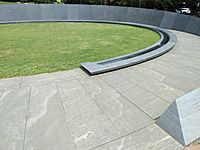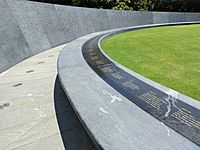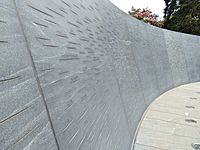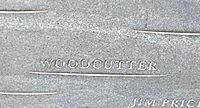Memorial to Enslaved Laborers facts for kids
Quick facts for kids Memorial to Enslaved Laborers |
|
|---|---|
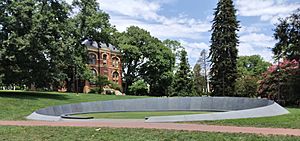 |
|
| Location | University of Virginia, Charlottesville, Virginia |
| Established | 2020 |
The Memorial to Enslaved Laborers is a special place built to honor the enslaved African Americans. These brave people built and worked at the University of Virginia in Charlottesville, Virginia.
Contents
About the Memorial
The memorial is located near the University of Virginia Corner. It's east of Brooks Hall and the famous Rotunda.
It has a wall made of local "Virginia Mist" granite. This wall is shaped like a broken ring. The broken ring shows broken shackles, which were used to hold enslaved people. It also shows that something is now complete.
Design and Size
The ring is about 80 feet (24 meters) wide. This size is similar to the Rotunda, a well-known building at the university. Inside the main ring, there is a second, smaller ring. This inner ring shows a timeline of slavery at the university. The grassy area inside the rings is a quiet place where people can gather. If you stand inside the rings, you can hear distant conversations.
Names and Notches
The outer ring is big enough for the names of about 4,000 enslaved people. These are the people known to have worked on the university grounds. As of 2020, 578 names are carved into the stone. Another 311 people are known only by their first name, their job, or their family connection.
For example, you might see "Jerry," "butler," "Agnes," "grandmother," or "midwife." Most of the ring is blank. It has small notches, which stand for the more than 3,000 people whose names are not known. If more names are found in the future, they will be added to the memorial.
Special Engravings
The outside of the wall has a subtle set of engraved eyes. These eyes were created by an artist named Eto Otitigbe. They come from a picture of Isabella Gibbons. She was an enslaved woman owned by professors at the university. After slavery ended, she became a teacher for freed African Americans.
Meaningful Directions
The memorial is lined up with two important paths. One path points towards the North Star. For enslaved people, the North Star was a guide to freedom. The second path lines up with the sunset on March 3rd. This date remembers the day Union soldiers freed the enslaved community in Charlottesville at the end of the Civil War. The city and university now celebrate this day as Liberation and Freedom Day.
There is also a group of gingko trees at the memorial. These trees remind us that this area used to be a farm. Enslaved laborers grew fruits and vegetables here long ago.
Building the Memorial
How the Idea Started
The idea for this memorial actually came from students. Their efforts began as early as 2007. That year, the university's leaders apologized for the institution of slavery. Another source says student efforts started around 2010.
Later, there was a competition for ideas on how the memorial should look. The President’s Commission on Slavery and the University (PCSU) helped guide the project.
Who Designed It
The memorial was designed by a team of experts. This team included Höweler+Yoon Architecture, Studio&, Gregg Bleam (a local landscape architect), Frank Dukes, and Eto Otitigbe. The university's Board of Visitors approved the final design in 2019.
Construction and Funding
Construction of the memorial began in January 2019. The granite slabs were put in place in October of that year.
The memorial was supposed to be officially opened on April 11, 2020. However, the university had to close shortly before that because of the coronavirus pandemic. The memorial cost about $6 million. This money came entirely from private donations.
Gallery
See also


